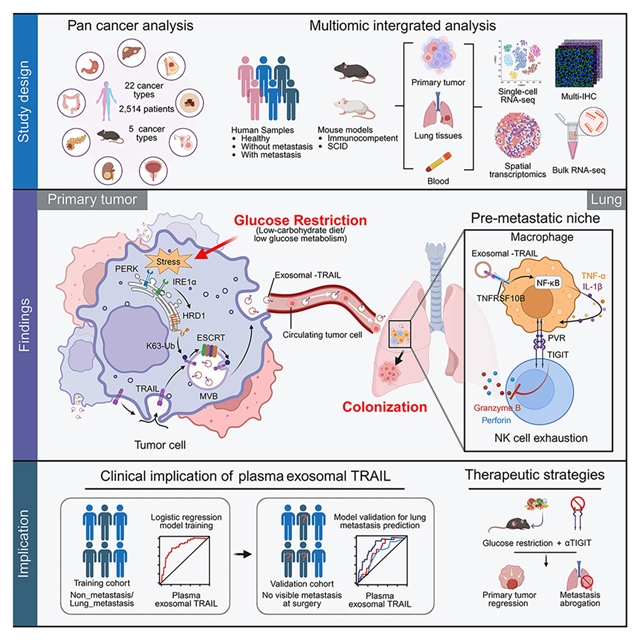
中山大学邝栋明团队的最新研究探明了葡萄糖限制通过外泌体TRAIL形成肺转移前先天免疫景观。2025年7月15日出版的《细胞》杂志发表了这项成果。
然而,小组在此发现了一个意想不到的悖论:虽然通过低碳水化合物饮食或原位代谢受损导致的葡萄糖剥夺抑制了原发性肿瘤的生长,但它同时通过肺巨噬细胞消耗自然杀伤细胞(NK)来促进肺转移。从机制上说,葡萄糖剥夺诱导内质网(ER)应激,激活HMG-CoA还原酶降解蛋白1 (HRD1),催化TRAIL的k63连锁泛素化,然后通过运输所需的内体分选复合物(ESCRT)复合物包装到外泌体中。这些外泌体TRAIL分子使PVR+巨噬细胞极化,触发NK细胞衰竭并建立转移前生态位。值得注意的是,阻断TIGIT不仅可以阻止葡萄糖剥夺引起的转移,还可以增强其抗肿瘤作用。临床上,在15种癌症类型中,低糖代谢与较高的术后2年复发率相关。
此外,血浆外泌体TRAIL在预测术后早期肺转移方面优于α-胎蛋白(AFP)和肿瘤大小等传统标志物,揭示了靶向糖代谢的风险和治疗潜力。
研究人员表示,靶向葡萄糖代谢已成为抑制肿瘤生长的一种有前途的策略。
附:英文原文
Title: Glucose restriction shapes pre-metastatic innate immune landscapes in the lung through exosomal TRAIL
Author: Cai-Yuan Wu, Chun-Xiang Huang, Xiang-Ming Lao, Zi-Wen Zhou, Jia-Hong Jian, Zheng-Xi Li, Yong-Yi Wu, Zheng-Yu Liu, Lei Chen, Lianxin Liu, Limin Zheng, Yuan Wei, Dong-Ming Kuang
Issue&Volume: 2025-07-15
Abstract: Targeting glucose metabolism has emerged as a promising strategy for inhibiting tumor growth. However, we herein uncover an unexpected paradox: while glucose deprivation through a low-carbohydrate diet or impaired in situ metabolism suppresses primary tumor growth, it simultaneously promotes lung metastasis by depleting natural killer (NK) cells via lung macrophages. Mechanistically, glucose deprivation induces endoplasmic reticulum (ER) stress, activating HMG-CoA reductase degradation protein 1 (HRD1) to catalyze K63-linked ubiquitination of TRAIL, which is then packaged into exosomes via the endosomal sorting complex required for transport (ESCRT) complex. These exosomal TRAIL molecules polarize PVR+ macrophages, triggering NK cell exhaustion and establishing a pre-metastatic niche. Notably, TIGIT blockade not only prevents metastasis induced by glucose deprivation but also enhances its anti-tumor effects. Clinically, low glucose metabolism correlates with higher 2-year postoperative recurrence across 15 cancer types. Furthermore, plasma exosomal TRAIL outperforms traditional markers, such as α-fetoprotein (AFP) and tumor size, in predicting early postoperative lung metastasis, revealing both the risks and therapeutic potential of targeting glucose metabolism.
DOI: 10.1016/j.cell.2025.06.027
Source: https://www.cell.com/cell/abstract/S0092-8674(25)00728-7
